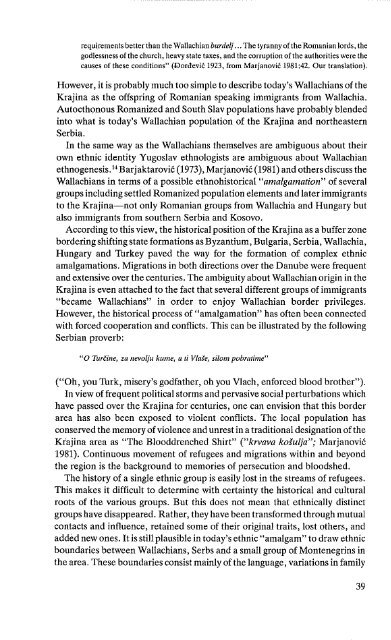Will they still be dancing? (1982)
Etnographic study of Romanians from East Serbia in Sweden in 1980s
Etnographic study of Romanians from East Serbia in Sweden in 1980s
You also want an ePaper? Increase the reach of your titles
YUMPU automatically turns print PDFs into web optimized ePapers that Google loves.
equirements <strong>be</strong>tter than the Wallachian burdelj ... The tyranny of the Romanian lords, the<br />
godlessness ofthe church, heavy state taxes, and the corruption ofthe authorities were the<br />
causes of these conditions" (Dordevic 1923, from Marjanovic 1981:42. Our translation).<br />
However, it is probably much too simple to descri<strong>be</strong> today's Wallachians of the<br />
Krajina as the offspring of Romanian speaking immigrants from Wallachia.<br />
Autocthonous Romanized and South Slav populations have probably blended<br />
into what is today's Wallachian population of the Krajina and northeastern<br />
Serbia.<br />
In the same way as the Wallachians themselves are ambiguous about their<br />
own ethnic identity Yugoslav ethnologists are ambiguous about Wallachian<br />
ethnogenesis. 14 Barjaktarovic (1973), Marjanovic (1981) and others discuss the<br />
Wallachians in terms of a possible ethnohistorical "amalgamation" of several<br />
groups induding settled Romanized population elements and later immigrants<br />
to the Krajina-not only Romanian groups from Wallachia and Hungary but<br />
also immigrants from southern Serbia and Kosovo.<br />
According to this view, the historical position ofthe Krajina as a buffer zone<br />
bordering shifting state formations as Byzantium, Bulgaria, Serbia, Wallachia,<br />
Hungary and Turkey paved the way for the formation of complex ethnic<br />
amalgamations. Migrations in both directions over the Danu<strong>be</strong> were frequent<br />
and extensive over the centuries. The ambiguity about Wallachian origin in the<br />
Krajina is even attached to the fact that several different groups ofimmigrants<br />
"<strong>be</strong>came Wallachians" in order to enjoy Wallachian border privileges.<br />
However, the historical process of "amalgamation" has often <strong>be</strong>en connected<br />
with forced cooperation and conflicts. This can <strong>be</strong> illustrated by the following<br />
Serbian proverb:<br />
"0 Turtine, za nevolju kume, a Ii Vlaie, silom pobratime"<br />
("Oh, you Turk, misery's godfather, oh you Vlach, enforced blood brother").<br />
In view of frequent political storms and pervasive social perturbations which<br />
have passed over the Krajina for centuries, one can envision that this border<br />
area has also <strong>be</strong>en exposed to violent conflicts. The local population has<br />
conserved the memory ofviolence and unrest in a traditional designation of the<br />
Kiajina area as "The Blooddrenched Shirt" ("krvava kosulja"; Marjanovic<br />
1981). Continuous movement of refugees and migrations within and <strong>be</strong>yond<br />
the region is the background to memories of persecution and bloodshed.<br />
The history of a single ethnic group is easily lost in the streams of refugees.<br />
This makes it difficult to determine with certainty the historical and cultural<br />
roots of the various groups. But this does not mean that ethnically distinct<br />
groups have disappeared. Rather, <strong>they</strong> have <strong>be</strong>en transformed through mutual<br />
contacts and influence, retained some of their original traits, lost others, and<br />
added new ones. Itis <strong>still</strong> plausible in today's ethnic "amalgam" to draw ethnic<br />
boundaries <strong>be</strong>tween Wallachians, Serbs and a small group of Montenegrins in<br />
the area. These boundaries consist mainly ofthe language, variations in family<br />
39
















